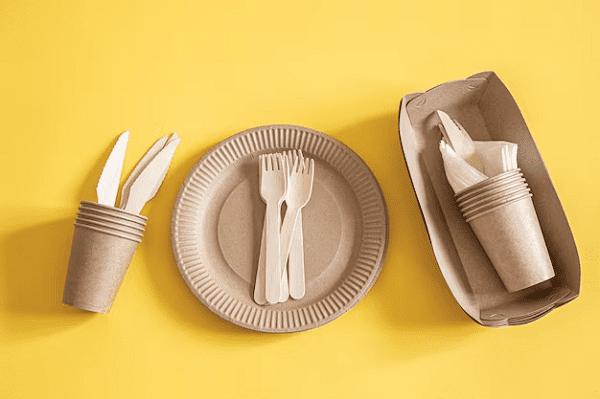Disposables- “Disposables” is a term that typically refers to single-use items or products that are designed to be used once and then thrown away. These items are not meant to be reused or recycled. Disposables are commonly used in various industries and daily life for convenience and hygiene purposes. Some common examples of disposable products include:
- Disposable Cutlery: Plastic forks, knives, and spoons that are used for eating and then discarded.
- Disposable Plates and Cups: Paper or plastic plates and cups used for serving food and beverages at events, parties, or for takeout.
- Disposable Diapers: Single-use diapers designed for infants and young children.
- Disposable Gloves: Latex or nitrile gloves used in medical settings, food preparation, and other applications where hygiene is crucial.
- Disposable Razors: Razors with disposable blades, which are discarded after a few uses.
- Disposable Cameras: Single-use film cameras that are used for capturing a limited number of photos and then processed.
- Disposable Contact Lenses: Soft contact lenses designed for daily or short-term use.
- Disposable Syringes: Sterile syringes used in healthcare for injections and medical procedures.
- Disposable Wipes: Pre-moistened wipes used for cleaning and personal hygiene.
- Disposable Food Containers: Takeout containers made from materials like foam, paper, or plastic.
The use of disposable products can raise environmental concerns due to the waste they generate. Many disposable items are made from non-biodegradable materials, such as plastic, which can contribute to environmental pollution and long-term ecological problems. In recent years, there has been a growing movement toward reducing the use of disposables in favor of more sustainable, reusable, or biodegradable alternatives to minimize their impact on the environment.
What is Disposables
“Disposables” is a broad term that refers to products or items that are intended for single or limited-use and are discarded after use. These items are not designed to be reusable or long-lasting. Disposables are often used for convenience, hygiene, or specific applications where a one-time use is more practical than cleaning, maintaining, or reusing a product. Some examples of disposable items include:
- Disposable Utensils: Forks, knives, spoons, and other eating utensils made from materials like plastic, wood, or bamboo.
- Disposable Tableware: Plates, cups, and bowls often made from paper, plastic, or foam, used for serving food and drinks at events, parties, or for takeout.
- Disposable Diapers: Single-use diapers designed for babies and young children.
- Disposable Gloves: Latex, nitrile, or vinyl gloves used in healthcare, food handling, and other settings where hygiene is crucial.
- Disposable Razors: Razors with replaceable or disposable blades, typically used for shaving.
- Disposable Cameras: Single-use film cameras that can be used for a limited number of photos and then need to be processed.
- Disposable Contact Lenses: Soft contact lenses meant for daily or short-term use.
- Disposable Syringes: Sterile syringes used in medical procedures and healthcare settings.
- Disposable Wipes: Pre-moistened cleaning or personal hygiene wipes designed for one-time use.
- Disposable Food Containers: Takeout containers made from materials like plastic, foam, or paper.
The use of disposable products can have environmental consequences, as many of them are made from non-biodegradable materials like plastics, contributing to waste and pollution. Efforts to reduce the use of disposables and promote more sustainable, reusable, or biodegradable alternatives have gained momentum in recent years as part of broader environmental and sustainability initiatives.
Who is Required Disposables
“Disposables” is a generic term that refers to products or items that are designed for single or limited use and are typically discarded after use. It’s not the name of a specific company or individual. Disposables can encompass a wide range of products, as I mentioned in previous responses, such as disposable cutlery, plates, diapers, gloves, razors, and more. If you’re looking for information about a specific company or brand with the name “Disposables,” you would need to provide more context or conduct an online search to find the relevant company or brand with that name.
When is Required Disposables

It appears that you might be looking for specific information or an event related to the term “Disposables,” but the term “Disposables” itself doesn’t refer to a specific date or time. It’s a generic term that describes products or items designed for single or limited use, such as disposable utensils, diapers, gloves, and more. If you are looking for information about a particular event or context involving disposables, please provide more details or specify what you’re referring to so that I can assist you more effectively.
How is Required Disposables
“Disposables” is a broad term referring to products or items that are designed for single or limited use and are typically discarded after use. The quality, characteristics, and properties of disposable items can vary significantly depending on the specific product. Here are some aspects to consider when discussing how disposables are:
- Materials: Disposables can be made from various materials, such as plastic, paper, foam, wood, or fabric, depending on their intended use. For example, disposable cutlery is often made from plastic, while disposable plates can be made from paper or plastic.
- Hygiene: Many disposables are used in situations where hygiene is important, such as disposable gloves in healthcare settings or disposable diapers for infants. These items are designed to be clean and sterile.
- Convenience: Disposables are often chosen for their convenience. They eliminate the need for washing or maintenance because they can be used once and then disposed of.
- Environmental Impact: Disposables, particularly those made from non-biodegradable materials like plastics, can have negative environmental impacts due to waste generation. Efforts are being made to develop more eco-friendly disposable alternatives.
- Variety: There is a wide variety of disposable items available to suit different needs, from disposable cameras for capturing memories to disposable razors for shaving.
The quality and performance of disposable items can vary based on the brand, manufacturer, and materials used, so it’s essential to consider these factors when choosing disposables for a particular purpose. Additionally, efforts are being made to promote the use of sustainable and eco-friendly disposable products to reduce their environmental impact.
Case Study on Disposables
Title: Reducing the Environmental Footprint of Disposable Cutlery in a Local Restaurant
Background: A small restaurant in a busy urban area has been using disposable plastic cutlery for its takeout and delivery orders. The restaurant’s management has become increasingly concerned about the environmental impact of these single-use plastics and wants to explore more sustainable alternatives.
Objectives:
- Reduce the use of disposable plastic cutlery.
- Minimize the restaurant’s environmental footprint.
- Maintain the convenience and hygiene standards of their service.
Approach:
1. Research and Analysis:
- Evaluate the environmental impact of the current disposable plastic cutlery, considering factors like production, transportation, waste generation, and recycling.
- Research and assess alternative options, such as biodegradable utensils made from materials like cornstarch or bamboo.
2. Customer Engagement:
- Inform customers about the restaurant’s commitment to reducing plastic waste.
- Encourage customers to choose reusable cutlery when dining in or opt for sustainable alternatives when ordering takeout or delivery.
3. Sustainable Procurement:
- Identify suppliers of eco-friendly disposable cutlery.
- Negotiate with suppliers to source biodegradable or compostable options and ensure the products meet quality standards.
4. Employee Training:
- Train staff on the proper handling and disposal of sustainable cutlery.
- Educate employees on the environmental benefits of these changes and involve them in the transition process.
5. Waste Management and Composting:
- Implement an efficient waste management system, including a separate bin for biodegradable cutlery.
- Collaborate with local composting facilities to ensure proper disposal of biodegradable items.
6. Monitoring and Reporting:
- Regularly assess and report the reduction in plastic cutlery usage and the environmental benefits.
- Communicate progress to customers and stakeholders through the restaurant’s website and social media channels.
Results: Over a period of six months, the restaurant successfully reduced its reliance on disposable plastic cutlery by 70%. This not only decreased their environmental impact but also resonated positively with customers who appreciated the restaurant’s commitment to sustainability. The composting of biodegradable cutlery significantly reduced waste sent to landfills.
Lessons Learned:
- Engaging customers and employees in the sustainability initiative is crucial.
- Sustainable procurement may involve higher costs, but these can be offset by marketing the restaurant as environmentally conscious.
- Regular monitoring and communication of progress are essential to maintain momentum.
This case study illustrates how a small restaurant can take steps to reduce its environmental impact by transitioning from traditional disposable plastic cutlery to more sustainable alternatives, benefiting both the environment and the business’s reputation.
White paper on Disposables
Abstract:
- Brief summary of the white paper’s key findings and recommendations.
1. Introduction:
- Background and significance of disposable products.
- Purpose and objectives of the white paper.
- Scope and limitations.
2. Types of Disposable Products:
- Categorization of disposable products (e.g., cutlery, diapers, gloves, containers).
- Overview of the materials used in disposable products.
3. Environmental Impact:
- Examination of the environmental consequences of disposable products.
- Discussion of waste generation, pollution, and resource depletion.
- Case studies highlighting the ecological footprint of select disposable products.
4. Sustainability and Alternatives:
- Exploration of sustainable alternatives to traditional disposables.
- Discussion of biodegradable materials, recycling, and reusables.
- Analysis of the pros and cons of different eco-friendly options.
5. Regulations and Standards:
- Overview of relevant regulations and standards governing disposable products.
- International and regional standards for product safety and environmental impact.
6. Consumer Behavior and Awareness:
- Discussion of consumer attitudes and behavior regarding disposable products.
- Strategies for raising awareness and encouraging more sustainable consumption.
7. Industry Trends and Innovations:
- Examination of the latest trends in the disposable products industry.
- Spotlight on innovative technologies and materials.
8. Case Studies:
- In-depth case studies of companies or initiatives successfully adopting eco-friendly disposable solutions.
9. Recommendations:
- Practical suggestions for consumers, businesses, and policymakers to reduce the environmental impact of disposable products.
10. Conclusion:
- Recap of the key findings and recommendations.
- Encouragement for a more sustainable approach to disposable products.
11. References:
- Citations and sources used in the white paper.
Remember that a white paper should be thoroughly researched and fact-based, providing an objective and comprehensive view of the subject matter. It is often used for educational or informational purposes, policy development, or to support business decisions.





